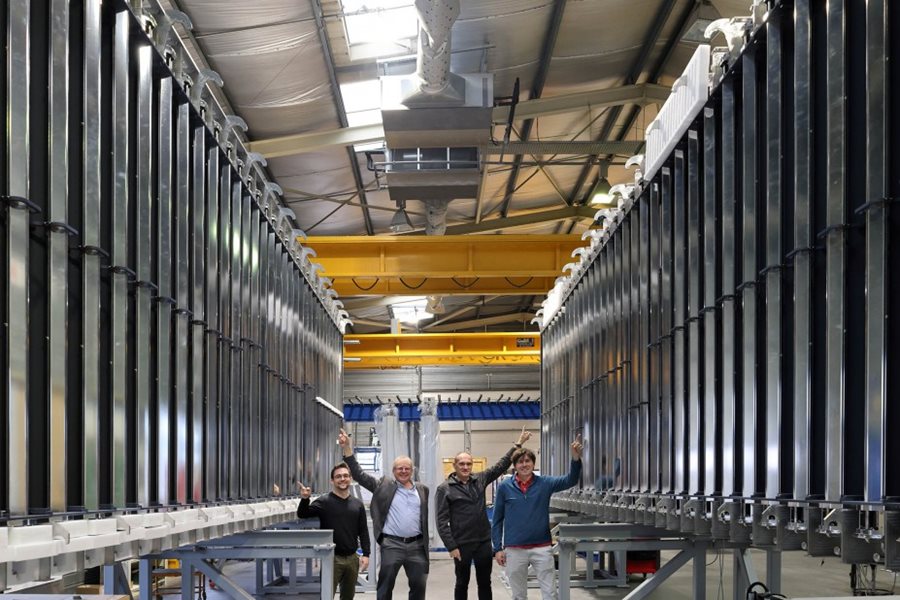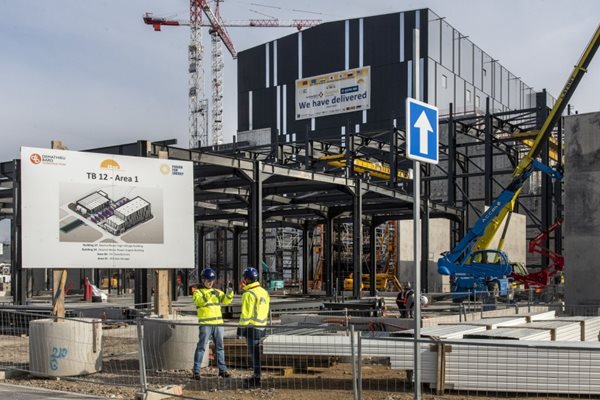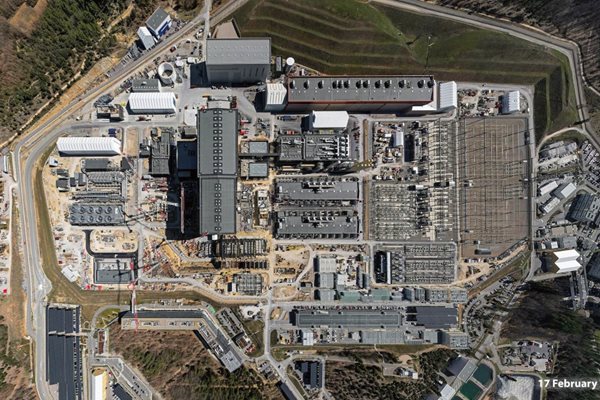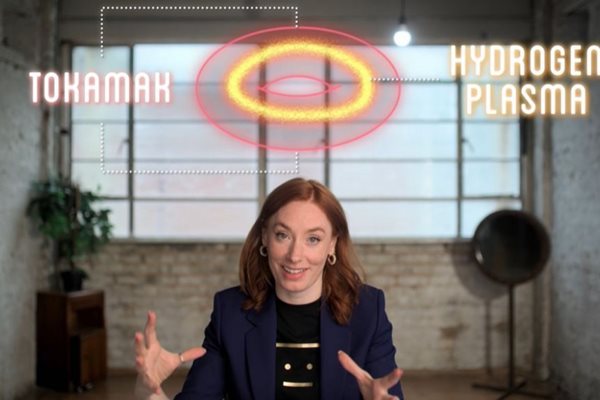
you're currently reading the news digest published from 13 Mar 2023 to 20 Mar 2023
featured3
of-interest1
press14
featured
MITICA | Cryopump passes site acceptance tests
Cryopumps, which play an essential role in ITER, are not what one has in mind when picturing a pump. A conventional pump creates negative pressure to suck in fluids such as water or air. Cryopumps, on the other hand, are based on a simple law of physics: when a molecule or an atom encounters an extremely cold surface, they lose the better part of their energy and slow down to near immobility; the colder a surface, the more irresistible is its power to 'hold' particles. When high vacuum is needed, cryopumps are indispensable to finalizing the initial pumping done by mechanical devices. ITER will use cryopumps to create high vacuum in the (aptly named) vacuum vessel, the cryostat, the 'beam boxes' of the neutral beam injection system, and a few other machine components and systems. In early March, the cryopump for MITICA, a real-size ITER neutral beam injector hosted by Consorzio RFX in Padua, Italy, successfully passed site acceptance tests. The delivery of this first-of-a-kind cryopump, similar in all respects to those that will equip the ITER neutral beams injectors, marks the culmination of a five-year manufacturing effort. Procurement was split between two highly specialized French contractors, Ravanat and SDMS, working under the supervision of the ITER Organization and the European Domestic Agency Fusion for Energy. 'What makes us proud is that this first-of-a-kind pump is the result of a big, unique ITER design,' says Robert Pearce, the Head of the ITER Vacuum Section. Although a cryopump is a 'passive' device with no moving parts, 'anything that operates at cryogenic temperature presents considerable challenges.' Located inside the injector's 'beam box' the cryopump will create the high-vacuum environment indispensable for accelerating and 'neutralizing' the energized particles shot into the plasma. Like the torus cryopumps that remove the helium 'ashes' from the plasma, the MITICA cryopump will also pump the gas load used in the neutralizing process (see box). During the accelerating and neutralizing phases, supercritical helium circulating through a dense web of piping will keep the pump's panels at the temperature of 4.5 K (minus 269 °C). However, during the 'regeneration' phase, when the gas particles trapped inside the panels need to be released, the same piping will accommodate a flux of gaseous helium at 125 °C—a huge temperature gradient that creates an 'accordion effect' in the component's stainless steel circuits. In the restricted space of the pump assembly (8 metres long, 2.8 metres high and 0.45 metres wide), contraction and expansion is a considerable issue that had to be taken into account during the design. 'In a way, it was like designing a whole plant that would alternately contract and expand like an accordion,' says vacuum cryopump engineer Jamie Buckerfield. As the MITICA facility is not fully operational yet, it may be some time before the cryopump can be tested at cryogenic temperatures. 'We have tested what we could: temperature sensors and the leak-tightness of the pipes at room temperature. But based on the analysis, prototyping and validation phases we have great confidence in our design.' See a 2022 story on MITICA cryopump manufacturing on the Fusion for Energy website.
Neutral beam power supply | Lightning-power voltage
In January 2021, preparatory works began for the construction of two large buildings designed to accommodate a unique set of electrical equipment. A little more than two years later, the main features of the new structures have emerged: steel frames, anchored in massive concrete slabs, rise up to 25 metres; thick walls mark out what looks like oversized horse stalls; and underground passages run deep and wide towards the adjacent Tokamak Complex. Civil works are approximately 40 percent complete: the neutral beam power supply infrastructure should be ready for equipment in about one year. Neutral beam heating is the workhorse of plasma-heating techniques, injecting high-energy particles into the plasma in order to bring it to the temperature at which fusion reactions can occur. 'Basically, a neutral beam injector is an ion accelerator. The speed of the particles, and hence the kinetic energy they can communicate to the plasma, is proportional to the voltage used to accelerate them,' explains Hans Decamps, the electrical engineer responsible for the ITER neutral beam power supply. In the European JET, presently the world's largest operating tokamak, the neutral beam system delivers an electrical voltage on the order of 130,000 volts; in the Euro-Japanese JT-60SA, it will reach 500,000 volts for a few minutes; in ITER, it will need to deliver one million volts (1MV) for durations of up to one hour. Such ultra-high voltage, sustained for such a long duration, is 'outside and beyond anything that's ever been done in terms of electrical engineering," says Decamps. Designing the system has required a full decade of research and development and the construction of full-scale mockups in a dedicated test facility. The level of the voltage required by the ITER neutral beam injectors has also determined the unusual features of the High Voltage Building—the largest of the two structures under construction, whose available space is equally split into three distinct halls: two devoted to the heating neutral beam injectors, and a third devoted to the diagnostic neutral beam injector (see box). The twin halls for the heating neutral beam system will be mostly empty, with the exception of two towering, alien-looking components: the 9-metre tall high-voltage deck sitting on its 6-metre tall insulating supports, as well as the even-taller bushing (16 metres) for the giant insulating transformer whose main body sits outside the building. The nature of these one-of-a-kind electrical powerhouses has imposed severe constraints on the building's interior design. To prevent the generation of electrical arcs, no element inside the halls can present a sharp angle or a protruding structure, and for safety reasons each deck is surrounded by a five-metre-radius "exclusion zone." Needless to say, no one will be admitted inside the building during operation. Inside the recently erected steel structure, the bright yellow beams of two overhead cranes are already in place. These cranes, with the capacity to lift 10 tonnes each, will travel the length of the heating neutral beam high-voltage halls. Less spectacular but no less strategic, the Neutral Beam Power Supply Building will host the electrical equipment—dry transformers, power convertors, rectifiers, inverters and other exotic devices—that will feed power to the high-voltage decks through the ten step-up transformers installed between the buildings. Like many components in the ITER installation, the neutral beam system operates in DC current. But contrary to the magnets for instance, which demand high current and low voltage, the neutral beam system requires low current and ultra-high voltage. This difference doesn't make the equipment smaller: procured by Japan, the ten 200 kV DCGs (a step-up transformer connected to a diode tank to obtain 200kV output DC voltage) for the heating neutral beam, each in its own stall separated by thick blast walls, are as large as the giant pulsed power network transformers in the ITER switchyard. Here again, it is the insulation requirements, particularly the quantity of oil that each transformer contains (up to 75,000 litres) that determines the size. Three smaller transformers will be dedicated to the diagnostics neutral beam system.) Only the raw forces of nature generate voltage higher than that of ITER's neutral beam power supply installation. But lightning strikes are millisecond events, whereas the formidable electrical installation on the ITER site is designed to steadily feed the injectors for hour-long plasma discharges. As such, it has no equivalent in the world.
Construction progress | Bird's eye views, three years apart
Taken three years apart (February 2020-February 2023) these two aerial photographs provide a spectacular illustration of progress on the ITER construction site. In February 2020, the roofing of the Tokamak Building at the centre of the photo is still a work in progress. It will be another four months before a large banner affixed to the building's north façade can proclaim, 'We have delivered.' The vast storage area for construction supplies seen on the left side of the 2020 image is now occupied by the completed Control Building, where servers and other systems are currently being installed. Also to the left, the cooling towers and heat rejection system were only partially realized three years ago. Today, all equipment is in place and this plant system is well into the commissioning phase. The landscape in front of the Tokamak Complex has also changed radically: the large open space, which used to be cluttered with worksite supplies and equipment, is now teeming with construction activity. The neutral beam power supply structures are clearly visible: steel frames rising 25 metres, thick separating walls for the massive transformers, deep trenches for the transmission lines... A new 'neighbourhood' has filled the space to the right of the Tokamak Complex, near the cryoplant and the twin buildings for magnet power conversion. This is the main ITER boulevard, spanned by the first of three planned bridges delivering cryogenic fluids or supporting the busbars that deliver power to the magnets. Another new feature on the ITER site: the parking lots for the ITER staff and contractors are now covered with solar panels, whose production exceeds the consumption of the ITER Headquarters Building and supplies electricity to 24 electric vehicle charging stations.
of-interest
Can Nuclear Fusion Power the Future?
It's the Holy Grail for limitless clean energy, but will nuclear fusion come soon enough to avoid the worst of the climate crisis? As part of the Bloomberg series The Future with Hannah Fry, follow Episode 4, "Can Nuclear Fusion Power the Future?" as Hannah visits the ITER Project in southern France, checks in with an expert at Imperial College London on the economics of fusion, and flies to Los Angeles to witness a new generation of private start-ups racing to put fusion energy on the grid. Her hosts at ITER are Richard Pitts, head of the Experiments & Plasma Operation Section, and Sabina Griffith, from Communication. Watch 'Can Nuclear Fusion Power the Future?' here. Browse all episodes here.



